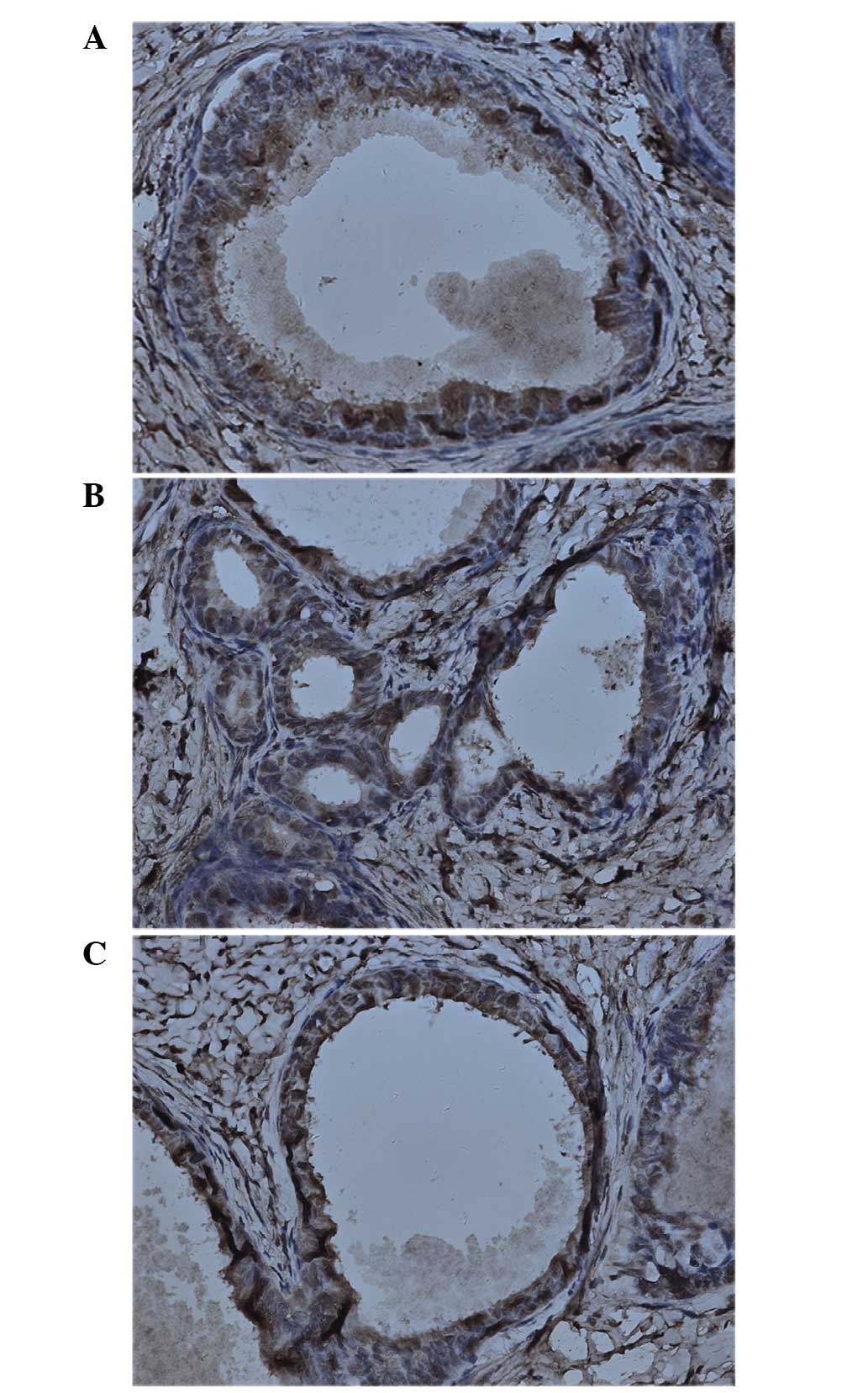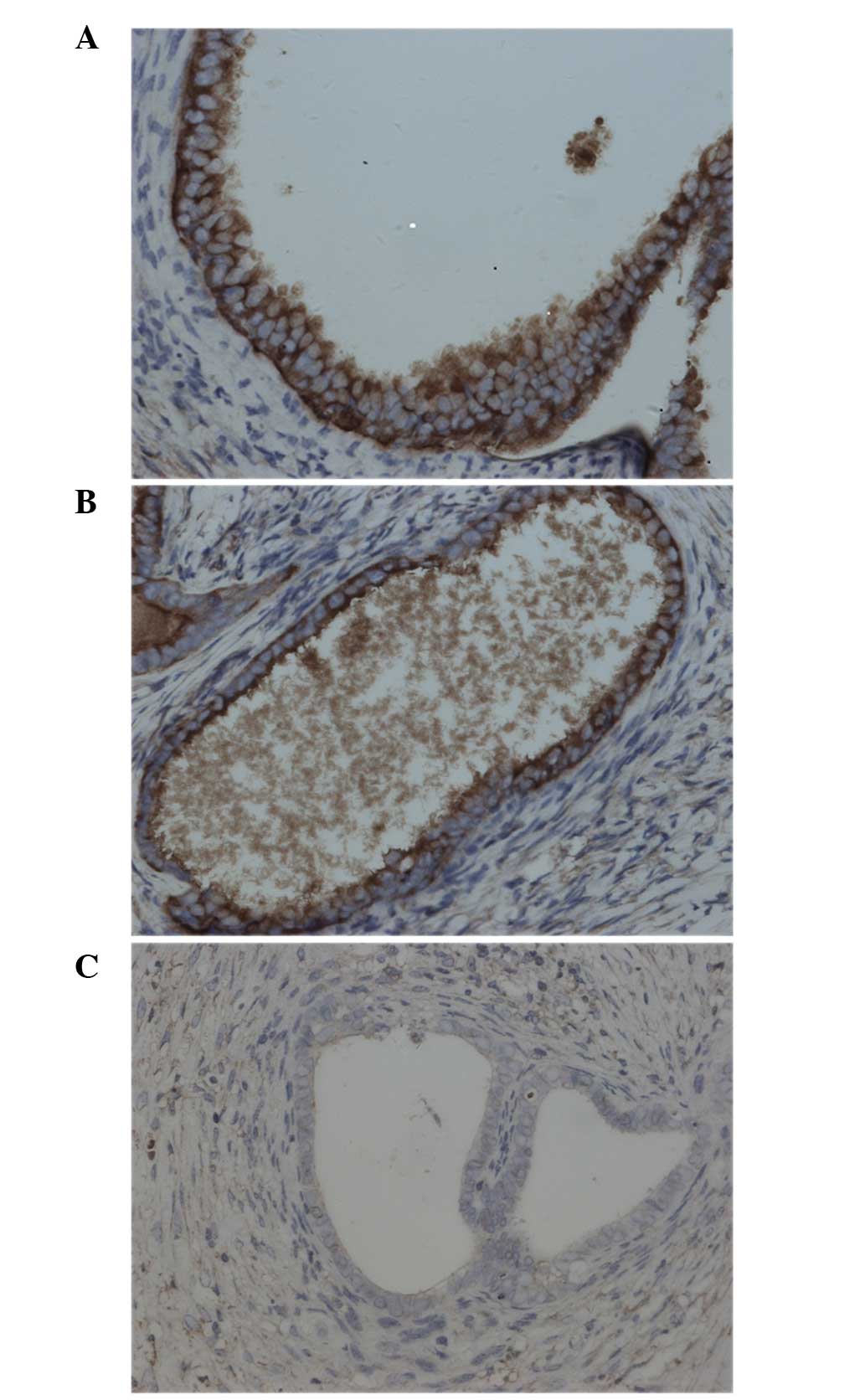|
1
|
Zhan L, Wang W, Zhang Y, Song E, Fan Y and
Wei B: Hypoxia-inducible factor-1alpha: A promising therapeutic
target in endometriosis. Biochimie. 123:130–137. 2016. View Article : Google Scholar : PubMed/NCBI
|
|
2
|
Khan KN, Kitajima M, Fujishita A, Hiraki
K, Matsumoto A, Nakashima M and Masuzaki H: Pelvic pain in women
with ovarian endometrioma is mostly associated with coexisting
peritoneal lesions. Hum Reprod. 28:109–118. 2013. View Article : Google Scholar : PubMed/NCBI
|
|
3
|
Huynh H: Molecularly targeted therapy in
hepatocellular carcinoma. Biochem Pharmacol. 80:550–560. 2010.
View Article : Google Scholar : PubMed/NCBI
|
|
4
|
Olivares-Reyes JA, Arellano-Plancarte A
and Castillo-Hernandez JR: Angiotensin II and the development of
insulin resistance: Implications for diabetes. Mol Cell Endocrinol.
302:128–139. 2009. View Article : Google Scholar : PubMed/NCBI
|
|
5
|
Makker A, Goel MM, Das V and Aqarwal A:
PI3K-Akt-mTOR and MAPK signaling pathways in polycystic ovarian
syndrome, uterine leiomyomas and endometriosis: An update. Gnnecol
Endocrinol. 28:175–81. 2012. View Article : Google Scholar
|
|
6
|
McKinnon BD, Kocbek V, Nirgianakis K,
Bersinger NA and Mueller MD: Kinase signalling pathways in
endometriosis: Potential targets for non-hormonal therapeutics. Hum
Reprod Update. Jan 5–2016.(Epub ahead of print). View Article : Google Scholar : PubMed/NCBI
|
|
7
|
Ashworth RE and Wu J: Mammalian target of
rapamycin inhibition in hepatocellular carcinoma. World J Hepatol.
6:776–782. 2014. View Article : Google Scholar : PubMed/NCBI
|
|
8
|
Beck JT, Ismail A and Tolomeo C: Targeting
the phosphatidylinositol 3-kinase (PI3K)/AKT/mammalian target of
rapamycin (mTOR) pathway: An emerging treatment strategy for
squamous cell lung carcinoma. Cancer Treat Rev. 40:980–989. 2014.
View Article : Google Scholar : PubMed/NCBI
|
|
9
|
Leconte M, Nicco C, Ngô C, Chéreau C,
Chouzenoux S, Marut W, Guibourdenche J, Arkwright S, Weill B,
Chapron C, et al: The mTOR/AKT inhibitor temsirolimus prevents deep
infiltrating endometriosis in mice. Am J Pathol. 179:880–889. 2011.
View Article : Google Scholar : PubMed/NCBI
|
|
10
|
Pugh CW and Ratcliffe PJ: Regulation of
angiogenesis by hypoxia: Role of the HIF system. Nat Med.
9:677–684. 2003. View Article : Google Scholar : PubMed/NCBI
|
|
11
|
Lu Z, Zhang W, Jiang S, Zou J and Li Y:
Effect of oxygen tensions on the proliferation and angiogenesis of
endometriosis heterograft in severe combined immunodeficiency mice.
Fertil Steril. 101:568–576. 2014. View Article : Google Scholar : PubMed/NCBI
|
|
12
|
Lu Z, Zhang W, Jiang S, Zou J and Li Y:
Effect of lesion location on endometriotic adhesion and
angiogenesis in SCID mice. Arch Gynecol Obstet. 289:823–830. 2014.
View Article : Google Scholar : PubMed/NCBI
|
|
13
|
Sharkey AM, Day K, McPherson A, Malik S,
Licence D, Smith SK and Charnock-Jones DS: Vascular endothelial
growth factor expression in human endometrium is regulated by
hypoxia. J Clin Endocrinol Metab. 85:402–409. 2000. View Article : Google Scholar : PubMed/NCBI
|
|
14
|
Ren X, He YL, Pan SL and Peng DX:
Expression of hypoxia-inducible factor-1alpha in endometriosis. Nan
Fang Yi Ke Da Xue Xue Bao. 27:538–540. 2007.(In Chinese).
PubMed/NCBI
|
|
15
|
Ren X, He Y and Peng D: The expression of
hypoxia-inducible factor-1α and the relationship with microvessel
density in endometriosis. Guangdong yi xue. 28:229–231. 2007.(In
Chinese).
|
|
16
|
Martin KA and Blenis J: Coordinate
regulation of translation by the PI 3-kinase and mTOR pathways. Adv
Cancer Res. 86:1–39. 2002. View Article : Google Scholar : PubMed/NCBI
|
|
17
|
Katsuki Y, Takano Y, Futamura Y, Shibutani
Y, Aoki D, Udagawa Y and Nozawa S: Effects of dienogest, a
synthetic steroid, on experimental endometriosis in rats. Eur J
Endocrinol. 138:216–226. 1998. View Article : Google Scholar : PubMed/NCBI
|
|
18
|
Weidner N: Current pathologic methods for
measuring intratumoral microvessel density with in breast carcinoma
and other solid tumors. Breast Cancer Res Treat. 36:169–180. 1995.
View Article : Google Scholar : PubMed/NCBI
|
|
19
|
Berkes E, Bokor A and Rigó J Jr.: Current
treatment of endometriosis with laparoscopic surgery. Orv Hetil.
151:1137–1144. 2010.(In Hungarian). View Article : Google Scholar : PubMed/NCBI
|
|
20
|
Young VJ, Ahmad SF, Brown JK, Duncan WC
and Horne AW: Peritoneal VEGF-A expression is regulated by TGF-β1
through an ID1 pathway in women with endometriosis. Sci Rep.
5:168592015. View Article : Google Scholar : PubMed/NCBI
|
|
21
|
Fujimoto J, Sakaguchi H, Hirose R, Wen H
and Tamaya T: Angiogenesis in endometriosis and angiogenic factors.
Gynecol Obstet Invest. 48(Suppl 1): 14–20. 1999. View Article : Google Scholar : PubMed/NCBI
|
|
22
|
Soysal D, Kizildag S, Saatli B, Posaci C,
Soysal S, Koyuncuoglu M and Dogan O: A novel angiogenesis inhibitor
bevacizumab induces apoptosis in the rat endometriosis model.
Balkan J Med Genet. 17:73–80. 2015.PubMed/NCBI
|
|
23
|
Uchida T, Rossignol F, Matthay MA, Mounier
R, Couette S, Clottes E and Clerici C: Prolonged hypoxia
differentially regulates hypoxia-inducible factor (HIF)-1alpha and
HIF-2alpha expression in lung epithelial cells: Implication of
natural antisense HIF-1alpha. J Biol Chem. 279:14871–14878. 2004.
View Article : Google Scholar : PubMed/NCBI
|
|
24
|
Jian-Lin Z, Hong-Song F, Hao P, Shuang D,
Shen C, Jian-Ping L, Bo Q, Jin-Qing W and Feng L: The relationship
between HIF-2α and VEGF with radiographic severity in the primary
osteoarthritic knee. Yonsei Med J. 57:735–740. 2016. View Article : Google Scholar : PubMed/NCBI
|
|
25
|
Bae WY, Choi JS, Kim JE and Jeong JW:
Cinnamic aldehyde suppresses hypoxia-induced angiogenesis via
inhibition of hypoxia-inducible factor-1α expression during tumor
progression. Biochem Pharmacol. 98:41–50. 2015. View Article : Google Scholar : PubMed/NCBI
|
|
26
|
Remels AH, Gosker HR, Verhees KJ, Langen
RC and Schols AM: TNF-α-induced NF-κB activation stimulates
skeletal muscle glycolytic metabolism through activation of HIF-1α.
Endocrinology. 156:1770–1781. 2015. View Article : Google Scholar : PubMed/NCBI
|
|
27
|
Shibuya M: Vascular endothelial growth
factor and its receptor system: Physiological functions in
angiogenesis and pathological roles in various diseases. J Biochem.
153:13–19. 2013. View Article : Google Scholar : PubMed/NCBI
|
|
28
|
Machado-Linde F, Pelegrin P,
Sanchez-Ferrer ML, Leon J, Cascales P and Parrilla JJ:
2-methoxyestradiol in the pathophysiology of endometriosis: Focus
on angiogenesis and therapeutic potential. Reprod Sci.
19:1018–1029. 2012. View Article : Google Scholar : PubMed/NCBI
|
|
29
|
Dufour M, Dormond-Meuwly A, Demartines N
and Dormond O: Tarageting the mammalian target of rapamycin (mTOR)
in cancer therapy: Lessions from past and future perspectives.
Cancers (Basel). 3:2478–2500. 2011. View Article : Google Scholar : PubMed/NCBI
|
|
30
|
Ganjoo K and Jacobs C: Antiangiogenesis
agents in the treatment of soft tissue sarcomas. Cancer.
116:1177–1183. 2010. View Article : Google Scholar : PubMed/NCBI
|
|
31
|
Sarbassov DD, Guertin DA, Ali SM and
Sabatini DM: Phosphorylation and regulation of AKT/PKB by the
rictor-mTOR complex. Science. 307:1098–1101. 2005. View Article : Google Scholar : PubMed/NCBI
|
|
32
|
Hudson CC, Liu M, Chiang GG, Otterness DM,
Loomis DC, Kaper F, Giaccia AJ and Abraham RT: Regulation of
hypoxia-inducible factor1 alpha expression and function by the
mammalian target of rapamycin. Mol Cell Biol. 22:7004–7014. 2002.
View Article : Google Scholar : PubMed/NCBI
|
|
33
|
Mirsgahi P, Toprak SK, Faussat AM,
Dubrulle S, Marie JP, Soria C, Soria J and Mirshahi M: Malignant
hematopoietic cells induce an increased expression of VEGFR-1 and
VEGFR-3 on bone marrow endothelial cells via AKT and mTOR
signalling pathways. Biochem Biophys Res Commun. 349:1003–1010.
2006. View Article : Google Scholar : PubMed/NCBI
|
|
34
|
Laschke MW, Elitzsch A, Scheuer C,
Holstein JH, Vollmar B and Menger MD: Rapamycin induces regression
of endometriotic lesions by inhibiting neovascularization and cell
proliferation. Br J Pharmacol. 149:137–144. 2006. View Article : Google Scholar : PubMed/NCBI
|












